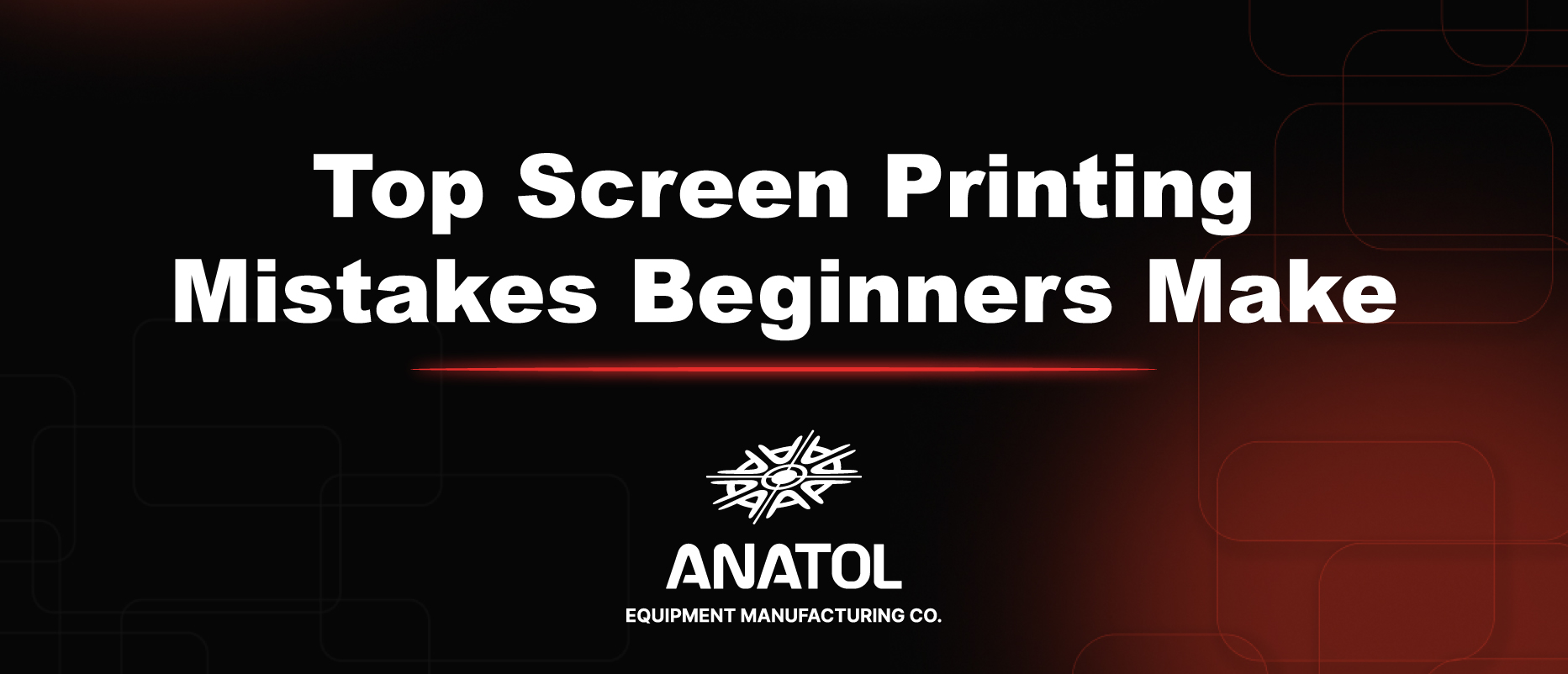No hay productos en el carrito.
es

Revolutionizing the screen printing industry through cutting-edge technology and quality service
Phone: +1 847-367-9760
Anatol Equipment Manufacturing Co.
1429 S Shields Dr
Waukegan, IL 60085

Revolutionizing the screen printing industry through cutting-edge technology and quality service
Anatol Equipment Manufacturing Co.
1429 S Shields Dr
Waukegan, IL 60085

Screen printing is an exciting craft that allows you to create vibrant, custom designs. However, beginners often face common screen printing mistakes that can lead to frustrating results.
From blurry prints to ink smudging, these errors can compromise print quality and waste valuable resources. Understanding these pitfalls is key to improving your skills.
Anatol, a top screen printing equipment brand, helps you avoid common screen printing mistakes with expert tips. Using tools like the VOLT automatic press, you can achieve professional-quality prints.
New to screen printing or want to improve? This article helps you avoid mistakes and achieve better prints.
A common screen printing mistake is setting the screen exposure time wrong, causing blurry or faded prints.
Solution: Use Anatol’s Quick Light PRO exposure unit for consistent and accurate exposure times. This equipment ensures sharp, durable stencils by allowing precise control over exposure settings. Always test your exposure time with a step wedge to avoid this screen printing mistake.
Improper off-contact distance between the screen and the substrate is another frequent screen printing mistake. Too little distance causes ink smudging, while too much leads to incomplete or uneven prints.
Solution: Anatol’s VOLT automatic press offers precise off-contact adjustments, ensuring optimal ink transfer and print clarity. Adjust the distance to 1/16 to 1/8 inch (1.5–3 mm) depending on your substrate for best results.
A common screen printing mistake is setting the screen exposure time wrong, causing blurry or faded prints. For instance, using a low mesh count for fine details can cause blurry prints.
Solution: Refer to Anatol’s guide on mesh count selection to choose the right mesh for your project. For detailed designs, use a higher mesh count (e.g., 200–300), while thicker inks require lower counts (e.g., 110–160).
Poorly mixed ink causes uneven colors and clogged screens, a common screen printing mistake for beginners. For example, poorly mixed plastisol ink can result in uneven color across prints.
Solution: Mix ink evenly with Anatol’s Formulator Ink Mixers to avoid uneven colors and clogged screens. This reduces waste and improves print consistency, helping you avoid this screen printing mistake.
Improper flash curing can cause ink smearing or poor adhesion between layers, especially in multi-color prints. This is a critical screen printing mistake that affects durability.
Solution: Anatol’s Flash Cure Units (Comet LIGHT, PRO, and SMART) provide precise temperature control and even heat distribution. Set the flash cure unit to the recommended temperature for your ink type to ensure proper curing between layers.
Failing to cure prints adequately is a screen printing mistake that leads to designs washing out after laundering. For example, under-cured plastisol ink may crack or fade after a single wash.
Solution: Use Anatol’s Solutions Mini Conveyor Dryer (SED-2404) for consistent and adjustable heat settings. Ensure your prints reach the recommended curing temperature (e.g., 320°F/160°C for plastisol) to achieve durable results.
Jumping into production without test prints is a costly screen printing mistake. Misalignment, wrong colors, or curing issues can ruin an entire batch.
Solution: Always run test prints to check alignment, color accuracy, and curing. Anatol’s equipment, like the VOLT press, allows for quick setup and adjustments, making test runs efficient and effective.
Neglecting regular maintenance can cause equipment malfunctions and unexpected downtime, impacting print quality. Beginners often miss this screen printing mistake.
Solution: Anatol designs its machines for easy maintenance, with accessible components and user-friendly interfaces. Schedule routine checks, such as cleaning screens and inspecting squeegees, to keep your equipment in top condition.
To illustrate these screen printing mistakes, consider the following scenarios:
Use the right techniques and equipment to avoid these examples of screen printing mistakes and create high-quality prints.
Blurry Prints: Wrong screen exposure time or mesh count creates unclear designs. Follow our tips above to fix this screen printing mistake with proper exposure and mesh selection.
Ink smudging is a common screen printing mistake caused by incorrect off-contact distance or improper flash curing. Use Anatol’s VOLT press and Flash Cure Units to ensure precise settings.
Anatol’s screen printing equipment is easy to use and precise. It helps beginners avoid mistakes and create professional-quality prints
Avoiding common screen printing mistakes is key to producing high-quality prints. The right tools make all the difference. Anatol’s VOLT automatic press, combined with expert advice, helps you print faster and achieve better results.
Ready to take your screen printing to the next level? Explore Anatol’s full range of equipment to find the perfect tools for your printing needs.
Your message was successfully sent!